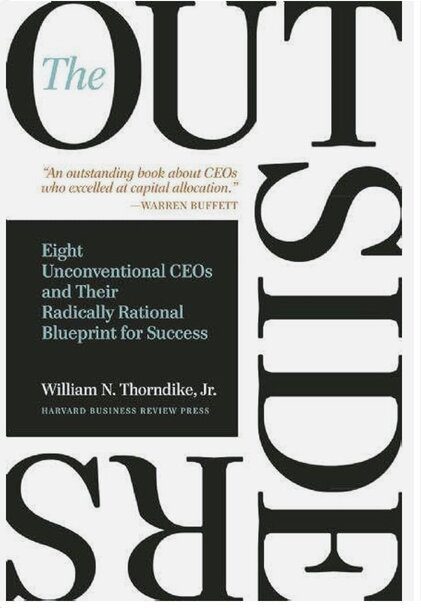“You are right not because others agree with you, but because your facts and reasoning are sound.—Benjamin Graham
In The Outsiders: Eight Unconventional CEOs and Their Radically Rational Blueprint for Success, author William N. Thorndike profiles eight unconventional CEOs whose firm average returns outperformed the S&P 500 by a factor of twenty—in other words, an investment of $10,000 with each of these CEOs, on average, would have been worth over $1.5 million twenty-five years later. Thorndike referred to these unconventional, radically rational chief executives as “The Outsiders.”
As a group, these CEOs faced the inherent uncertainty of the business world with a patient, rational, pragmatic opportunism, not a detailed set of strategic plans.
The eight CEOs profiled in the outsiders include:
1. Tom Murphy – Capital Cities Broadcasting
2. Henry Singleton – Teledyne
3. Bill Anders – General Dynamics
4. John Malone – TCI
5. Katharine Graham – The Washington Post Company
6. Bill Stiritz – Ralston Purina
7. Dick Smith – General Cinema
8. Warren Buffett – Berkshire Hathaway
The outsider CEOs achieved extraordinary relative results by consistently zigging while their peers zagged. In their zigging, they followed a virtually identical blueprint: they disdained dividends, made disciplined (occasionally large) acquisitions, used leverage selectively, bought back a lot of stock, minimized taxes, ran decentralized organizations, and focused on cash flow over reported net income.
The outsider CEOs achieved extraordinary relative results by consistently zigging while their peers zagged.
The Outsider Mindset
Always Do the Math
The outsider CEOs always started by asking what the return was. Every investment project generates a return, and the math is really just fifth-grade arithmetic, but these CEOs did it consistently, used conservative assumptions, and only went forward with projects that offered compelling returns. They focused on the key assumptions, did not believe in overly detailed spreadsheets, and performed the analysis themselves, not relying on subordinates or advisers.
The outsider CEOs believed that the value of financial projections was determined by the quality of the assumptions, not by the number of pages in the presentation, and many developed succinct, single-page analytical templates that focused employees on key variables.
The Denominator Matters
These CEOs shared an intense focus on maximizing value per share. To do this, they didn’t simply focus on the numerator, total company value, which can be grown by any number of means, including overpaying for acquisitions or funding internal capital projects that don’t make economic sense. They also focused intently on managing the denominator through the careful financing of investment projects and opportunistic share repurchases.
These repurchases were not made to prop up stock prices or to offset option grants (two popular rationales for buybacks today) but rather because they offered attractive returns as investments in their own right.
A Feisty Independence
The outsider CEOs were master delegators, running highly decentralized organizations and pushing operating decisions down to the lowest, most local levels in their organizations. They did not, however, delegate capital allocation decisions. In addition to thinking independently, they were comfortable acting with a minimum of input from outside advisers.
Charisma Is Overrated
The outsider CEOs were also distinctly unpromotional and spent considerably less time on investor relations than their peers. They did not offer earnings guidance or participate in Wall Street conferences. As a group, they were not extroverted or overly charismatic.
A Crocodile-Like Temperament
That Mixes Patience . . . Armed with their return calculations, all (with the notable exception of John Malone, who was constantly buying cable companies in pursuit of scale) were willing to wait long periods of time (in the case of Dick Smith at General Cinema, an entire decade) for the right opportunity to emerge. Like Katharine Graham, many of them created enormous shareholder value by simply avoiding overpriced “strategic” acquisitions, staying on the sidelines during periods of acquisition feeding frenzy.
. . . With Occasional Bold Action
Interestingly, as we’ve seen, this penchant for empiricism and analysis did not result in timidity. Just the opposite, actually: on the rare occasions when they found projects with compelling returns, they could act with boldness and blinding speed. Each made at least one acquisition or investment that equaled 25 percent or more of their firm’s enterprise value. Tom Murphy made one (ABC) that was greater than his entire company’s value.”
The Consistent Application of a Rational, Analytical Approach to Decisions Large and Small
These executives were capital surgeons, consistently directing available capital toward the most efficient, highest-returning projects. Over long periods of time, this discipline had an enormous impact on shareholder value through the steady accretion of value-enhancing decisions and (equally important) the avoidance of value-destroying ones.
This unorthodox mind-set, in itself, proved to be a substantial and sustainable competitive advantage for their companies. It provided the equivalent of polarized lenses, allowing the outsider CEOs to cut through the glare of peer activity and conventional wisdom to see the core economic reality and make decisions accordingly.
A Long-Term Perspective
Although frugal by nature, the outsider CEOs were also willing to invest in their businesses to build long-term value. To do this, they needed to ignore the quarterly earnings treadmill and tune out Wall Street analysts and the cacophony of cable shows like Squawk Box and Mad Money, with their relentless emphasis on short-term thinking.
The outsider CEOs tended to dance when everyone else was on the sidelines and to cling shyly to the periphery when the music was loudest. They were intelligent contrarians willing to lean against the wall indefinitely when returns were uninteresting.
Temperament, not Intellect
Their specific actions stemmed from a broader, shared mindset and added up to nothing less than a new model for CEO success, one centered on the optimal management of firm resources. Although the outsider CEOs were an extraordinarily talented group, their advantage relative to their peers was one of temperament, not intellect. Fundamentally, they believed that what mattered was clear-eyed decision making, and in their cultures they emphasized the seemingly old-fashioned virtues of frugality and patience, independence and (occasional) boldness, rationality and logic.
The Outsider’s Checklist
“1. The allocation process should be CEO led, not delegated to finance or business development personnel.
2. Start by determining the hurdle rate—the minimum acceptable return for investment projects (one of the most important decisions any CEO makes).
3. Calculate returns for all internal and external investment alternatives, and rank them by return and risk (calculations do not need to be perfectly precise). Use conservative assumptions.
4. Calculate the return for stock repurchases. Require that acquisition returns meaningfully exceed this benchmark.
5. Focus on after-tax returns, and run all transactions by tax counsel.
6. Determine acceptable, conservative cash and debt levels, and run the company to stay within them.
7. Consider a decentralized organizational model. (What is the ratio of people at corporate headquarters to total employees—how does this compare to your peer group?)
8. Retain capital in the business only if you have confidence you can generate returns over time that are above your hurdle rate.
9. If you do not have potential high-return investment projects, consider paying a dividend. Be aware, however, that dividend decisions can be hard to reverse and that dividends can be tax inefficient.
10. When prices are extremely high, it’s OK to consider selling businesses or stock. It’s also OK to close under-performing business units if they are no longer capable of generating acceptable returns.
All the best in your quest to get better. Don’t Settle: Live with Passion.



Comments are closed.